Looker dubs as a fully-fledged data platform that is part of the Google Cloud. It combines data analytics with modern business intelligence features to provide businesses with real-time insights based on the data they generate. With the tool, your business can create custom data experiences, explore data conclusively, visualize it, and collaborate with other teams to implement the results of the insights it collects.
This tool connects to multiple data sources without requiring additional connectors. It helps you make decisions based on all-around data without having to do complex data extractions or transformations.
We noted that many customers tend to confuse Looker with Loker Studio. Looker Studio is a simple window where users integrate Google products using connectors. However, Looker is a fully-fledged tool that combines looks, merge queries, warehouse integrations, and dashboards. This makes it a better tool for organizations looking for advanced visualization and analytics.
Looking at factors like ease of use, cost of integrating discrete vs continuous data, data visualization, and integration with various data sources, can you reliably use Looker for your business needs? Let’s find out in this comprehensive review.
Looker Functionality
The tool has key features that make it easy to visualize and analyze your data. Here are the main features.
- Custom Dashboards: You can build visually appealing and interactive dashboards that present data in a clear, actionable format. You can then create reports based on your insights.
- LookML: This is a unique modeling language that one can use to create reusable data models for consistent analysis.
- Integration Capabilities: Connects directly to databases like BigQuery to create a customized data collection form for analysis using updated data.
- Embedded Analytics: Embed Looker’s analytics into your website, applications, or internal tools to share insights easily.
- Collaboration: Share reports and dashboards with teams for enhanced collaboration and unified business operations.
Looker Data Transfer
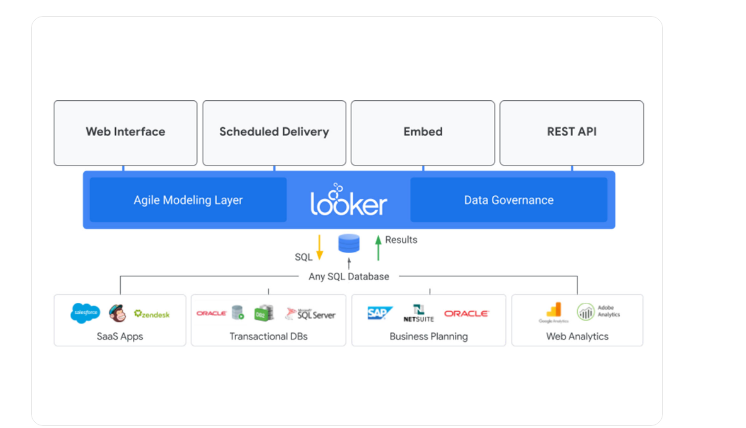
You enjoy a seamless data transfer by connecting Looker directly to data warehouses like AWS Redshift, Snowflake, and BigQuery. This way, it eliminates the need to extract data and enables you to use up-to-date data for visualization and analysis. It also enables you to use SQL queries to establish a connection, which makes the process fast and efficient.
Here is the process for setting up data transfer on Looker.
- Connect to your database through Looker’s supported integrations.
- Build your data model using LookML for consistent data definitions.
- Start to transfer data by using SQL queries to determine what rows you need to move.
Looker Reporting
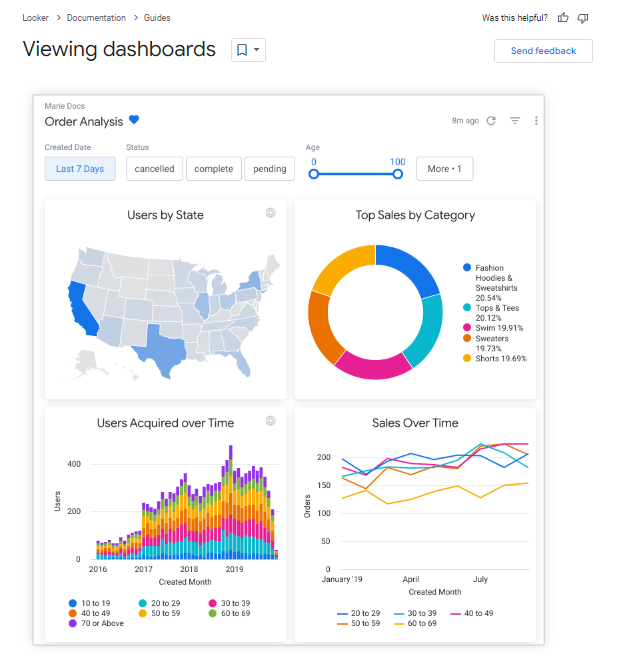
Looker allows you to generate customizable reports in a few clicks. You can choose relevant fields, apply filters, and visualize your data in various formats like tables, charts, or graphs. With the ability to schedule and automatically deliver reports, Looker helps streamline your reporting process, ensuring you get timely insights without manually generating reports each time.
Additionally, Looker Blocks provides pre-built reports and templates, helping you jump-start your analysis without needing to build from scratch. You can automate reporting on specific variables you capture during your analytics, such as search engine ranking reports, so that your team makes informed decisions based on up-to-date data.
Looker Customer Support
Looker offers multiple customer support options on Google Cloud. You can pick the option that best works for your business.
- Support Center: Look through a comprehensive set of guides, FAQs, and tutorials. These help with quick answers to issues you may be facing with the tool.
- Community Forum: Interact with other Looker users to get advice and find solutions.
- Email Support: Submit a support request and receive prompt responses from Looker’s customer service team.
- Training Programs: Join Looker’s training sessions to deepen your understanding of the platform.
- Premium support: You may upgrade to Standard, Enhanced, and Premium support to get tailored support from Google Cloud technical teams.
We found positive customer feedback on the support options provided as well as the quality of assistance they received. Here is one of the customer reviews.

Looker Price Breakdown
Look pricing is tailored to your specific needs and flexible in that you only pay for the features that you use. There is no difference between discrete and continuous data when it comes to costs. as the tool does not charge as per the volume of data you move. This makes it one of the cheapest marketing analytics tools for organizations with varied data sources. Let’s explore how the pricing works.
Looker Free Trial
Looker gives you a free trial where you get $300 in free Google Cloud credits. During the free trial, you access all the Looker features so that you can test its capabilities.
Google Cloud gives you three options for free use:
- Google Cloud Free Tier: Perfect for small-scale projects, offering limited access to Looker and other Google Cloud services.
- Free Looker Credits: Use your $300 credits to explore Looker’s features.
- Proof of Concept (POC) Assistance: Get help from Google Cloud experts to build a POC and test Looker in your business environment.
Looker Price Packages
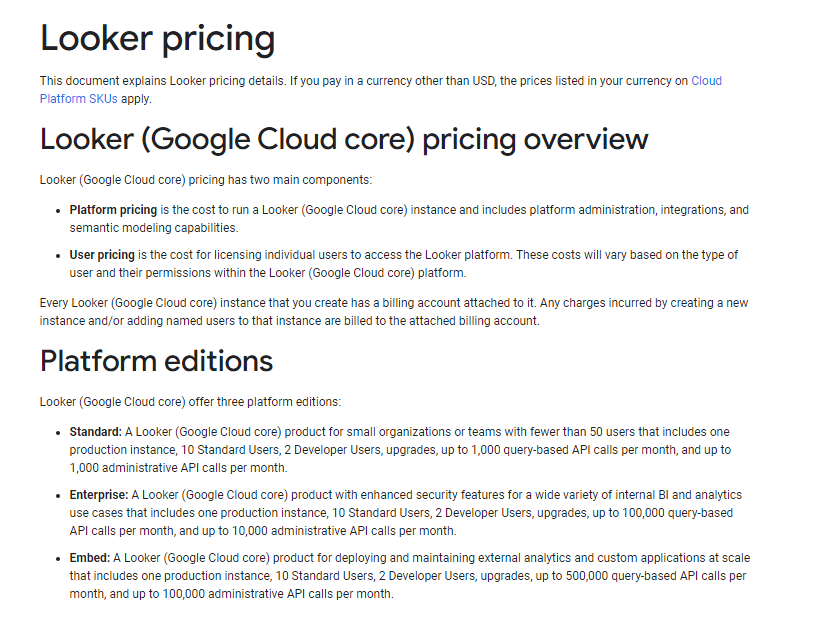
Looker provides pricing packages based on your specific needs. It offers three platform editions, each offering specific tools and capabilities. There are two pricing components: the cost of running Looker instances, including its administration and integrations. There is also user pricing, the cost of licensing individual users.
- Standard: This is a product for small organizations of less than 50 users and one production instance. It includes 10 users, two developers, and 1,000 query-based API calls a month.
- Enterprise: This user product comes with enhanced security features. It includes one production instance, 10 users, two developers, and up to 100,000 query-based API calls per month.
- Embed: This tool offers capabilities to deploy and maintain external analytics and custom applications at scale. It includes one production instance, 10 users, 2 developers, and up to 500,000 query-based API calls per month.
For exact pricing details, you’ll need to contact Looker’s sales team. They will work with you to create a pricing model that aligns with your organization’s scale and objectives.
Remember, each instance you create on Looker comes with an additional billing account. Its pricing will depend on the kind of users you add to it.
Looker Customer Reviews
We explored different customer reviews to ascertain the quality of service provided by Looker. A key concern users mention with this platform is technical challenges when integrating data. Here are two we picked at random.


This client mentions a couple of advantages of Looker. Justifiably, Looker is highly intuitive, although it may not give the best experience for beginners. Small teams may also find the platform costly to use.
Looker Pros and Cons
| Pros | Cons |
| Its Integration with Google Cloud services and BigQuery enables you to analyze updated data always. | A steep learning curve for beginners: Setting up the Looker tool and running its features requires technical knowledge. |
| Real-time data analysis without extraction reduces the costs and tasks of extracting data and makes the process fast. | Can be expensive for smaller businesses: The lack of definitive pricing and bundled offers can make this quite expensive to small businesses with just a few data sources. |
| Customizable dashboards and reusable models make it easy to visualize and analyze data. | Limited offline functionality: You need to always be online to access the features of Looker. |
| Excellent customer support and training options: There are free tools and premium services to help you use the tool effectively. |
Verdict
Looker is an effective business intelligence tool that enables you to leverage data from different sources, including cloud-based warehouses, for analysis and visualization. It has a robust data collection form that integrates data from these sources so that you can analyze it with ease using customizable dashboards.
This tool is integrated into Google Cloud, which makes it easier to integrate it with other Google tools like BigQuery, Workspace, and Analytics. While it has a long learning curve, you will get lots of training and support options to get you on board. Finally, our comparison of continuous vs discrete data pricing found it best for continuous data as it does not price features based on data volume.
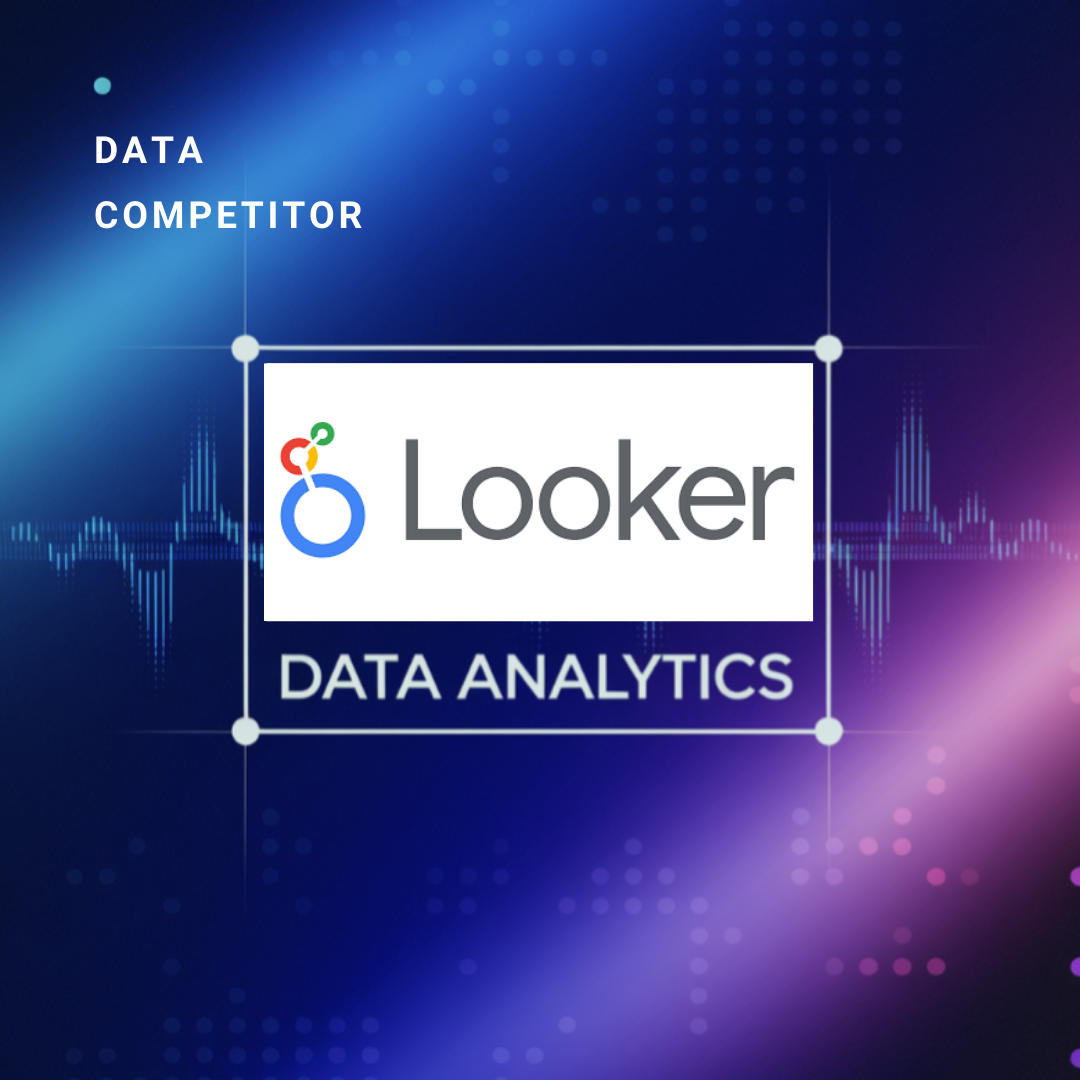
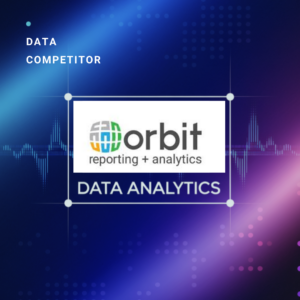

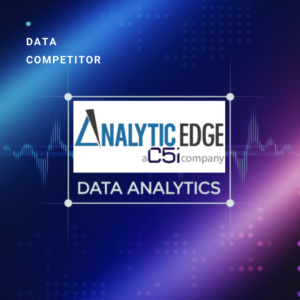

Leave a Reply